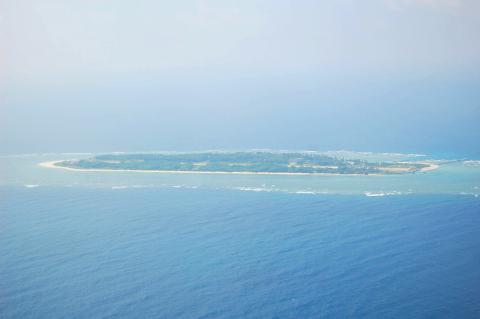Taiwan will launch oil exploration efforts in waters off Itu Aba Island (Taiping Island, 太平島) next year, in a move that is likely to raise tensions with other claimants to a series of islets in the South China Sea.
During a meeting at the legislature in Taipei yesterday, Bureau of Energy officials confirmed that the Ministry of Economic Affairs’ Bureau of Mines, in cooperation with CPC Corp, Taiwan (CPC, 台灣中油), would send ships to waters near Itu Aba to conduct exploration for potential oil resources next year.
Bureau of Energy Director-General Jerry Ou (歐嘉瑞) told the Foreign Affairs and National Defense Committee that a monthly budget of NT$17 million (US$583,670) would be allocated to fund the efforts.

Photo: CNA
Ou said that as Taiwan is almost entirely dependent on imports for its oil supply, it was imperative for the nation to diversify its energy sources.
Though unproven, the South China Sea is believed to contain important oil and gas resources. Taiwan, China, Vietnam, the Philippines, Malaysia and Brunei all lay claim to parts of the area.
Administered by Taiwan, Itu Aba is the largest islet in the disputed Spratly Islands (Nansha Islands, 南沙群島). It lies about 1,400km from Greater Kaohsiung.
In 2008, Taiwan finished constrcution of a 1,150m airstrip on the island. Earlier this year, the Coast Guard Administration — which is mandated with defending sovereignty over the island — augmented its equipment on Itu Aba with a supply of T63 120mm mortar systems and L/60 40mm anti-aircraft guns, sparking protests among other claimants, including Vietnam and the Philippines.
Asking for a progress report, Chinese Nationalist Party (KMT) Legislator Lin Yu-fang (林郁方), a strong supporter of Taiwan playing a more muscular role in the area, was assured that the plan had advanced past the “paperwork phase” and would be initiated as early as next month.
It has yet to be confirmed whether the exploration boats will be accompanied by coast guard vessels.
KMT Legislator Chen Cheng-hsiang (陳鎮湘) said the government should actively mine the waters near the Spratlys and the Pratas Islands (Dongsha Islands, 東沙群島) and establish a forward base in the area to oversee energy, fishing and environmental protection.
He also said a multilateral center should be established to lower the risks of sovereignty disputes with other countries.
On March 22, two coast guard speedboats were dispatched to intercept a pair of Vietnamese patrol vessels that had entered waters near Taiping, prompting the Ministry of Foreign Affairs to file a protest with Hanoi.
Two other ships entered waters near the island on March 26. The coast guard subsequently denied reports that shots had been fired during the incident.

Tropical Storm Gaemi strengthened into a typhoon at 2pm yesterday, and could make landfall in Yilan County tomorrow, the Central Weather Administration (CWA) said yesterday. The agency was scheduled to issue a sea warning at 11:30pm yesterday, and could issue a land warning later today. Gaemi was moving north-northwest at 4kph, carrying maximum sustained winds near its center of up to 118.8kph and gusts of 154.8kph. The circumference is forecast to reach eastern Taiwan tomorrow morning, with the center making landfall in Yilan County later that night before departing from the north coast, CWA weather forecaster Kuan Shin-ping (官欣平) said yesterday. Uncertainty remains and

SEA WARNING LIKELY: The storm, named Gaemi, could become a moderate typhoon on Wednesday or Thursday, with the Taipei City Government preparing for flooding A tropical depression east of the Philippines developed into a tropical storm named Gaemi at 2pm yesterday, and was moving toward eastern Taiwan, the Central Weather Administration (CWA) said. Gaemi could begin to affect Taiwan proper on Tuesday, lasting until Friday, and could develop into a moderate typhoon on Wednesday or Thursday, it said. A sea warning for Gaemi could be issued as early as Tuesday morning, it added. Gaemi, the third tropical storm in the Pacific Ocean this typhoon season, is projected to begin moving northwest today, and be closest to Taiwan on Wednesday or Thursday, the agency said. Today, there would likely

DISRUPTIONS: The high-speed rail is to operate as normal, while several airlines either canceled flights or announced early departures or late arrivals Schools and offices in 15 cities and counties are to be closed today due to Typhoon Gaemi, local governments announced last night. The 15 are: Taipei, New Taipei City, Taoyuan, Tainan, Keelung, Hsinchu and Kaohsiung, as well as Yilan, Hualien, Hsinchu, Miaoli, Chiayi, Pingtung, Penghu and Lienchiang counties. People should brace for torrential rainfall brought by the storm, with its center forecast to make landfall on the east coast between tonight and tomorrow morning, the Central Weather Administration (CWA) said. The agency issued a sea warning for the typhoon at 11:30pm on Monday, followed by a land warning at 11:30am yesterday. As of

CASUALTY: A 70-year-old woman was killed by a falling tree in Kaohsiung as the premier warned all government agencies to remain on high alert for the next 24 hours Schools and offices nationwide are to be closed for a second day today as Typhoon Gaemi crosses over the nation, bringing torrential rain and whipping winds. Gaemi was forecast to make landfall late last night. From Tuesday night, its outer band brought substantial rainfall and strong winds to the nation. As of 6:15pm last night, the typhoon’s center was 20km southeast of Hualien County, Central Weather Administration (CWA) data showed. It was moving at 19kph and had a radius of 250km. As of 3pm yesterday, one woman had died, while 58 people were injured, the Central Emergency Operation Center said. The 70-year-old